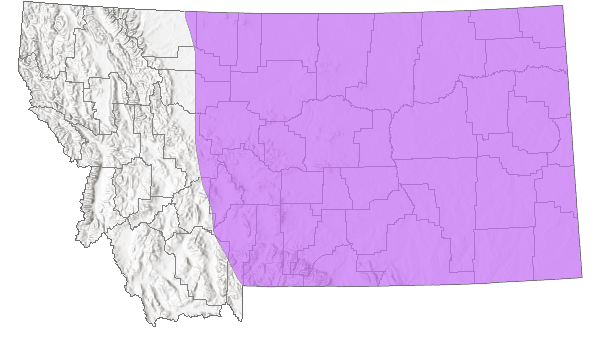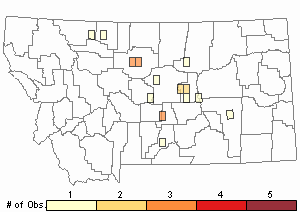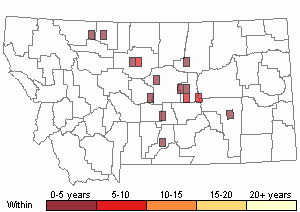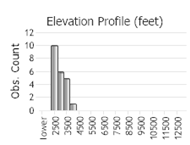View in other NatureServe Network Field Guides
NatureServe
Montana
Utah
Wyoming
Idaho
Wisconsin
British Columbia
South Carolina
Yukon
California
New York
Twelve-spotted Tiger Beetle - Cicindela duodecimguttata
Native Species
Global Rank:
G5
State Rank:
S4
Agency Status
USFWS:
USFS:
BLM:
External Links
General Description
The following is taken from Wallis (1961), Graves and Brzoska (1991), Kippenhan (1994), Knisley and Schultz (1997), Leonard and Bell (1999), Acorn (2001), and Pearson et al (2015). Body length is 12-15 mm, perhaps shorter in the west (11-13 mm). Dark brown to blackish above with copper reflections, maculations thin and complete to broken into dots and short lines, often totaling 12. Middle band on elytra is usually constricted or broken below the abrupt rearward bend and thinly connected at right angle to a short marginal line on edge of elytra, outer edges of elytra bowed out and wide, front constriction on thorax not as deep as the rear (giving thorax a trapezoidal shape instead of a more uniform width). Underside is metallic purple to blue-green, sides of thorax coppery. Forehead hairy, labrum short with a single dark tooth.
Phenology
Tiger beetle life cycles fit two general categories based on adult activity periods. “Spring-fall” beetles emerge as adults in late summer and fall, then overwinter in burrows before emerging again in spring when mature and ready to mate and lay eggs. The life cycle may take 1-4 years. “Summer” beetles emerge as adults in early summer, then mate and lay eggs before dying. The life cycle may take 1-2 years, possibly longer depending on latitude and elevation (Kippenhan 1994, Knisley and Schultz 1997, and Leonard and Bell 1999). Adult Cicindela duodecimguttata, a spring-fall species, across its range April-June then August-October (Pearson et al. 2015), March-October (Larochelle and Larivière 2001). March-June and August-October in Nebraska (Carter 1989), June-September in South Dakota (Kirk and Balsbaugh 1975), late March to early October in Colorado (Kippenhan 1994). Incomplete information for Montana; at least early July to mid-September (Nate Kohler personal communication, iNaturalist 2023).
Diagnostic Characteristics
The following largely comes from Kippenhan (1994), Acorn (2001), and Pearson et al. (2015). Most similar in our region to the
Bronzed Tiger Beetle (
C. repanda) and
Western Tiger Beetle (
C. oregona).
Bronzed Tiger Beetle differs by being lighter in color with thicker and complete maculations, a front (shoulder) maculation forming a “C” and connected (or only slightly separated) from white line along the outer edge of the elytra, the pronotum (thorax) about the same width in front and back (more uniformly wide).
Western Tiger Beetle differs by the shoulder maculation consisting of only two dots, not sometimes connected to form a thin “C” shape, the middle maculation lacks a connecting line along the middle margin of elytra, the forehead with only a few hairs. Hybrids between Twelve-spotted Tiger Beetle and
Western Tiger Beetle are common along the eastern slopes of the Rocky Mountains, and show intermediate characteristics.
Species Range
Montana Range
Range Descriptions

 Native
Native
Range Comments
Cicindela duodecimguttata is present across the United States and southern Canada, from the Rocky Mountains to the Atlantic coast north of Virginia, absent from much of the southeast Atlantic Coast and desert southwest (Wallis 1961, Knisley and Schultz 1997, Leonard and Bell 1999, Acorn 2001, and Pearson et al. 2015). Present throughout most of Montana east of the Rocky Mountains yet absent in the southwestern-most counties.
Observations in Montana Natural Heritage Program Database
Number of Observations: 23
(Click on the following maps and charts to see full sized version)
Map Help and Descriptions
Relative Density

Recency



 (Observations spanning multiple months or years are excluded from time charts)
(Observations spanning multiple months or years are excluded from time charts)
Migration
Non-migratory but capable of dispersal. When wings are fully developed (macropterous), it is a good flier, fast runner, capable of swimming across small pools of water, early to colonize new disturbed sites, and attracted to lights at night (Larochelle and Larivière 2001).
Habitat
Adult and larval tiger beetle habitat is essentially identical, the larvae live in soil burrows (Knisley and Schultz 1997). Across the range Cicindela duodecimguttata is usually found near water in sparse vegetation but also wooded or shaded areas, preferring clay, sandy, and muddy river banks, lake shores, stream banks, sand pits and gravel pits, sandy roads, wet fields and meadows, bogs, trails, road and railroad cuts, roadside ditches, coastal beaches, alkali flats and mud flats (Vaurie 1950, Wallis 1961, Hooper 1969, Carter 1980, Kippenhan 1994, Knisley and Schultz 1997, Leonard and Bell 1999, Acorn 2001, Larochelle and Larivière 2001, Kritsky and Smith 2005, and Pearson et al. 2015). In Montana, habitat is poorly described but includes lake, river, and stream shores and banks, fishing access sites, saline flats, to at least 4070 ft (1241 m) elevation (Nate Kohler personal communication, iNaturalist 2023).
Food Habits
Larval and adult tiger beetles are predaceous. In general, both feed considerably on ants (Wallis 1961, and Knisley and Schultz 1997). Diet of adult Cicindela duodecimguttata in the field includes various dead insects along shorelines, small flies, pygmy mole crickets (tridactylids); in captivity, mealworms, flies, ants, and lean meat. Larval food in captivity includes lean meat (Larochelle and Larivière 2001).
Ecology
Larval tiger beetles live in burrows and molt through three instars to pupation, which also occurs in the larval burrow. Adults make shallow burrows in soil for overnight protection, deeper burrows for overwintering. Adults are sensitive to heat and light and are most active during sunny conditions. Excessive heat during midday on sunny days drives adults to seek shelter among vegetation or in burrows (Wallis 1961, Knisley and Schultz 1997).
Cicindela duodecimguttata has a broad range of ecological tolerance (eurytopic). Larval burrows are often highly aggregated, excavated in moist soil of humus, sand, or clay, larvae leave burrows for moister localities when burrows get too hot or dry (Shelford 1908, and Larochelle and Larivière 2001). Adults are mostly diurnal but sometimes nocturnal (attracted to lights at night), often gregarious. Tends to occur on dry upper banks in morning then moves to moister sites nearer water during hottest times of day. Hides at night and on cloudy days in self-constructed burrows or under dead leaves. Overwinter burrows of adults and larvae excavated in banks 1-4 m from edge of water. Predators across range include birds (flycatchers) and asilid (robber) flies. Wary, escapes by running or flying a few meters, and produces a musky scent when captured. Associated tiger beetle species include
C. denverensis,
C. fulgida,
C. lengi,
C. limbalis,
C. nebraskana,
C. [= Ellipsoptera] nevadica,
C. oregona,
C. purpurea,
C. repanda,
C. scutellaris,
C. [=Parvindela] terricola, and
C. tranquebarica (Criddle 1907, Kippenhan 1994, Larochelle and Larivière 2001, and Kritsky and Smith 2005).
Reproductive Characteristics
Life cycle of
Cicindela duodecimguttata is 2 years, both adults and third instar larvae overwinter, adults in burrows 15-50 cm deep, deeper in sand (average of 40 cm) than clay (average of 18 cm), sometimes 2-3 individuals in the same burrow. Larval burrows (third instar) 15-38 cm in winter, 6-13 cm deep in summer (Criddle 1907, Knisley and Schultz 1997, Leonard and Bell 1999, Acorn 2001, Larochelle and Larivière 2001, and Pearson et al. 2015). Mating May to July, copulation lasts about 2-3 minutes. Interspecific copulations reported with
C. oregona, and
C. repanda. Pupation is in August, pupal length is 10-11 mm. Fresh adults (tenerals) emerge July-August, are active to October then overwinter and reach sexual maturity the following spring, emerging in April to mate and oviposit through early summer (Shelford 1908, Knisley and Schultz 1997, and Larochelle and Larivière 2001). Little information exists for Montana; mating reported in early August (iNaturalist 2023).
Management
Not considered rare or in need of special conservation management (Knisley et al. 2014). Cicindela duodecimguttata can benefit from particular anthropogenic disturbances that create suitable habitat, such as agricultural fields and orchards, sand or gravel pits, and dredge spoils following operations to maintain or clear ditch or canal channels. Encroachment of native and exotic plants could become a problem at local scales where they invade moist open habitats along river and stream courses as well as shores of lakes and reservoirs. Larval burrows could be impacted by trampling through livestock overgrazing or concentrations at water sources, but grazing at appropriate times and stocking levels could also be beneficial by keeping vegetation cover more open (Knisley 2011).
Stewardship Responsibility
References
- Literature Cited AboveLegend:
 View Online Publication
View Online Publication Acorn, J. 2001. Tiger beetles of Alberta: killers on the clay, stalkers on the sand. The University of Alberta Press, Edmonton, Alberta. 120 p.
Acorn, J. 2001. Tiger beetles of Alberta: killers on the clay, stalkers on the sand. The University of Alberta Press, Edmonton, Alberta. 120 p. Carter, M. R. 1989. The biology and ecology of the tiger beetles (Coleoptera: Cicindelidae) of Nebraska. Transactions of the Nebraska Academy of Sciences XVII: 1-18.
Carter, M. R. 1989. The biology and ecology of the tiger beetles (Coleoptera: Cicindelidae) of Nebraska. Transactions of the Nebraska Academy of Sciences XVII: 1-18. Criddle, N. 1907. Habits of some Manitoba 'tiger beetles' (Cicindela). Canadian Entomologist 39:105-114.
Criddle, N. 1907. Habits of some Manitoba 'tiger beetles' (Cicindela). Canadian Entomologist 39:105-114. Graves, R.C. and D.W. Brzoska. 1991. The tiger beetles of Ohio (Coleoptera: Cicindelidae). Bulletin of the Ohio Biological Survey New Series 8. 42 p.
Graves, R.C. and D.W. Brzoska. 1991. The tiger beetles of Ohio (Coleoptera: Cicindelidae). Bulletin of the Ohio Biological Survey New Series 8. 42 p. Hooper, R.R. 1969. A review of Saskatchewan tiger beetles. Cicindela 1(4):1-5.
Hooper, R.R. 1969. A review of Saskatchewan tiger beetles. Cicindela 1(4):1-5. iNaturalist. Research-grade Observations. Accessed 5 November 2023. https://www.inaturalist.org/
iNaturalist. Research-grade Observations. Accessed 5 November 2023. https://www.inaturalist.org/ Kippenhan, Michael G. 1994. The Tiger Beetles (Coleoptera: Cicindelidae) of Colorado. 1994. Transactions of the American Entomological Society 120(1):1-86.
Kippenhan, Michael G. 1994. The Tiger Beetles (Coleoptera: Cicindelidae) of Colorado. 1994. Transactions of the American Entomological Society 120(1):1-86. Kirk, V.M. and E.U. Balsbaugh, Jr. 1975. A list of beetles of South Dakota. Brookings, SD: South Dakota State University. Agricultural Experiment Station, Technical Bulletin 42. 139 pages.
Kirk, V.M. and E.U. Balsbaugh, Jr. 1975. A list of beetles of South Dakota. Brookings, SD: South Dakota State University. Agricultural Experiment Station, Technical Bulletin 42. 139 pages. Knisley, C.B. 2011. Anthropogenic disturbances and rare tiger beetle habitats: benefits, risks, and implications for conservation. Terrestrial Arthropod Reviews 4:41-61.
Knisley, C.B. 2011. Anthropogenic disturbances and rare tiger beetle habitats: benefits, risks, and implications for conservation. Terrestrial Arthropod Reviews 4:41-61. Knisley, C.B., and T.D. Schultz. 1997. The biology of tiger beetles and a guide to the species of the south Atlantic states. Virginia Museum of Natural History Special Publication Number 5. 210 p.
Knisley, C.B., and T.D. Schultz. 1997. The biology of tiger beetles and a guide to the species of the south Atlantic states. Virginia Museum of Natural History Special Publication Number 5. 210 p. Knisley, C.B., M. Kippenhan, and D. Brzoska. 2014. Conservation status of United States tiger beetles. Terrestrial Arthropod Reviews 7:93-145.
Knisley, C.B., M. Kippenhan, and D. Brzoska. 2014. Conservation status of United States tiger beetles. Terrestrial Arthropod Reviews 7:93-145. Kohler, Nathan S. Excel spreadsheets of tiger beetle observations. 6 August 2022.
Kohler, Nathan S. Excel spreadsheets of tiger beetle observations. 6 August 2022. Kritsky, G. and J. Smith. 2005. Teddy's tigers: the Cicindelidae (Coleoptera) of Theodore Roosevelt National Park, North Dakota. Cicindela 37(1-2):1-16
Kritsky, G. and J. Smith. 2005. Teddy's tigers: the Cicindelidae (Coleoptera) of Theodore Roosevelt National Park, North Dakota. Cicindela 37(1-2):1-16 Larochelle, A and M Lariviere. 2001. Natural history of the tiger beetles of North America north of Mexico. Cicindela. 33:41-162.
Larochelle, A and M Lariviere. 2001. Natural history of the tiger beetles of North America north of Mexico. Cicindela. 33:41-162. Leonard, Jonathan G. and Ross T. Bell, 1999. Northeastern Tiger Beetles: a field guide to tiger beetles of New England and eastern Canada. Boca Raton, FL: CRC Press. 176 p.
Leonard, Jonathan G. and Ross T. Bell, 1999. Northeastern Tiger Beetles: a field guide to tiger beetles of New England and eastern Canada. Boca Raton, FL: CRC Press. 176 p. Pearson, D.L., C.B. Knisley, D.P. Duran, and C.J. Kazilek. 2015. A field guide to the tiger beetles of the United States and Canada, second edition. New York, NY: Oxford University Press. 251 p.
Pearson, D.L., C.B. Knisley, D.P. Duran, and C.J. Kazilek. 2015. A field guide to the tiger beetles of the United States and Canada, second edition. New York, NY: Oxford University Press. 251 p. Shelford, V.E. 1908. Life-histories and larval habits of the tiger beetles (Cicindelidae). The Journal of the Linnean Society 30:157-184.
Shelford, V.E. 1908. Life-histories and larval habits of the tiger beetles (Cicindelidae). The Journal of the Linnean Society 30:157-184. Vaurie, P. 1950. Notes on the habitats of some North American tiger beetles. Journal of the New York Entomological Society 58(3):143-153.
Vaurie, P. 1950. Notes on the habitats of some North American tiger beetles. Journal of the New York Entomological Society 58(3):143-153. Wallis, J.B. 1961. The Cicindelidae of Canada. Toronto, Ontario, Canada: University of Toronto Press. 74 p.
Wallis, J.B. 1961. The Cicindelidae of Canada. Toronto, Ontario, Canada: University of Toronto Press. 74 p.
- Additional ReferencesLegend:
 View Online Publication
View Online Publication
Do you know of a citation we're missing? Bousquet, Yves. 2012. Catalogue of Geadephaga (Coleoptera; Adephaga) of America north of Mexico. ZooKeys. 245:1-1722.
Bousquet, Yves. 2012. Catalogue of Geadephaga (Coleoptera; Adephaga) of America north of Mexico. ZooKeys. 245:1-1722. Pearson, D.L., C.B. Knisley, and C.J. Kazilek. 2006. A field guide to the tiger beetles of the United States and Canada: identification, natural history, and distribution of the Cicindelidae. Oxford University Press, New York, New York. 227 pp.
Pearson, D.L., C.B. Knisley, and C.J. Kazilek. 2006. A field guide to the tiger beetles of the United States and Canada: identification, natural history, and distribution of the Cicindelidae. Oxford University Press, New York, New York. 227 pp.
- Web Search Engines for Articles on "Twelve-spotted Tiger Beetle"
- Additional Sources of Information Related to "Insects"





